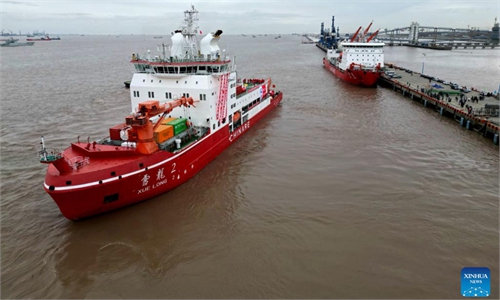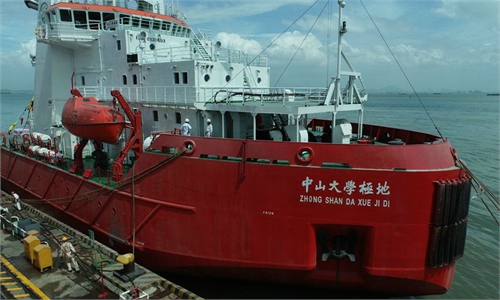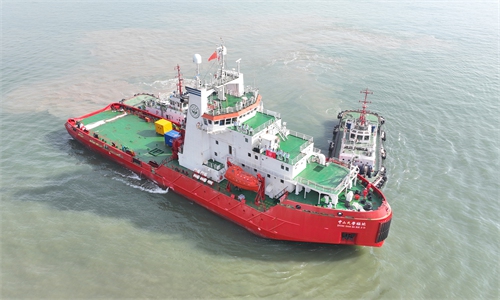China's polar icebreaker conducts sea trials, to boost country's research capability in polar studies
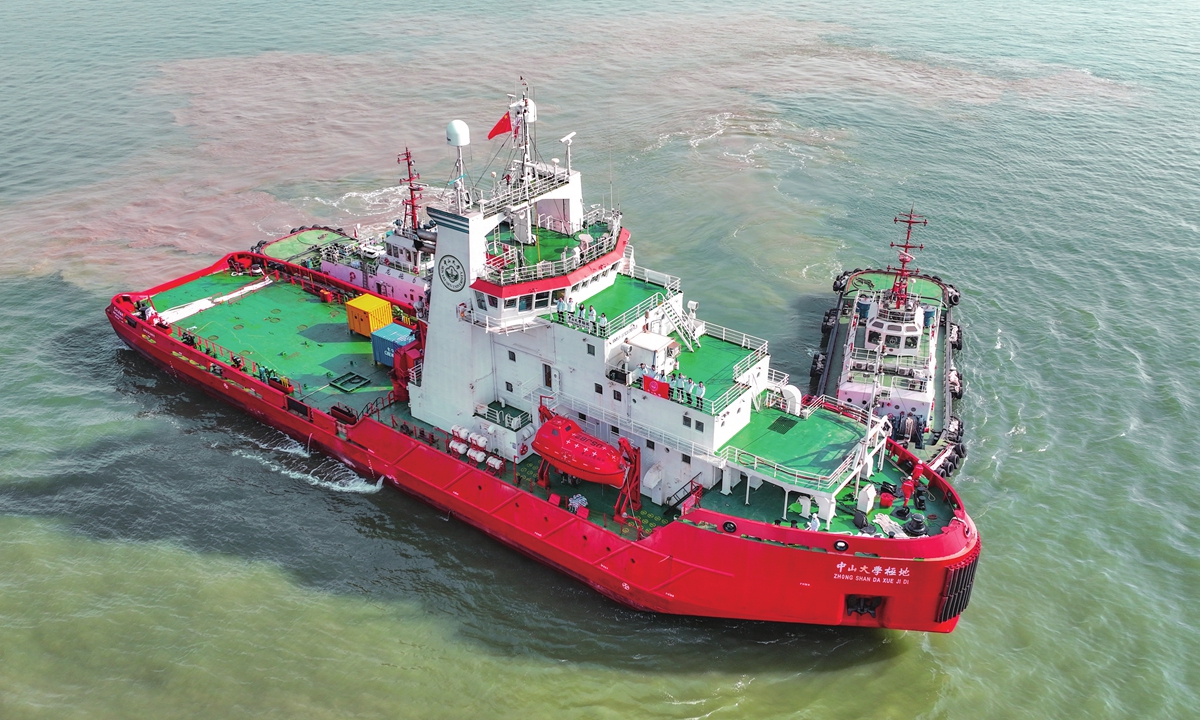
Zhong Shan Da Xue Ji Di, China's third icebreaker, owned by China's Sun Yat-sen University, also known as the Zhongshan University Photo: Deng Xiaoci/GT
"I am honored to be a member of the first batch of the scientific expedition team of the Zhong Shan Da Xue Ji Di and I hope it would soon take me to the Arctic," Zhao Xi, an associate professor at the Sun Yat-sen University's School of Geospatial Engineering and Science, wrote on February 3 inside the ship's meeting room during its first sea trials.
After concluding successful sea trials in Liaodong Bay, Bohai Sea, the polar icebreaker Zhong Shan Da Xue Ji Di, the first of its kind ever owned by a Chinese university, returned to the Guangzhou Wenchong Dockyard in Guangzhou, South China's Guangdong Province, at around 10 am on February 3.
A total of 32 crew members were onboard the ship during the sea trials, including 12 researchers from the ship's owner, the Sun Yat-sen University, also known as the Zhongshan University.
Zhao was part of the twelve-strong research team. Members of the team spent their Chinese New Year holidays away from their families while participating in the sea trials. Zhao received a warm welcome from her children, and her husband when they were reunited.
Zhong Shan Da Xue Ji Di is China's third polar icebreaker after Xuelong and Xuelong-2. It set out on January 17 to the South China Sea, then voyaged through fierce winter winds and waves across the East China Sea and the Yellow Sea before arriving in Liaodong Bay.
The ship was built in the 1980s as an icebreaking anchor-handling tug supply vessel (AHTS) for BeauDrill, the drilling subsidiary of Gulf Canada Resources, and was acquired by Sun Yat-sen University in 2021.
Although the ship is more than 40 years old and hasn't been in operation for nearly two years, it is still in good condition in terms of the ship's body structure and power system. "We have carried out repair and conversion works to some of its cabins and added research equipment and appliances to make it meet the requirements for cruises in the polar region and for scientific explorations. The sea trials were to verify the results of such improvements," Cheng Xiao, chief scientist for the icebreaker's maiden journey, told the Global Times.
"It was one lucky journey for us, as we encountered the fiercest cold front this winter. The Bohai Bay ice covered a vast area and was consistent, and the temperature came to as low as -20C, accompanied by a strong wind, which provided a perfect polar-like experiment environment for the icebreaker, fully verifying its icebreaking capability as well as scientific service capacity," Cheng, who is also a professor with the university's School of Geospatial Engineering and Science, noted.
The 1,500-nautical-mile journey across four seas tested and verified the ship's long-distance operation capability and also verified that it possesses a world-leading icebreaking capability at PC4 (Polar Class-4), Cheng said.
Sun Yat-sen University has equipped the icebreaker with a range of scientific chambers including the oceanic physics lab and chemistry lab. Many of the scientific appliances onboard are domestically developed, and their performance is just as good as foreign-made equipment, which is another characteristic of the icebreaker, Yuan Yuan, an associate professor with the university's School of Geospatial Engineering and Science, and a member of the first crew batch of the icebreaker, told the Global Times.
More appliance installation and renovation work is expected to be carried out before the ship sets out for further trials, Yuan revealed.
The icebreaker, with a length of 78.95 meters and a width of 17.22 meters, has a displacement of 5,852 tons and a draft of 8.16 meters. It was converted and renovated at the Guangzhou Wenchong Dockyard, a subsidiary of the Guangzhou Shipyard International Co. Limited under the China State Shipbuilding Corporation Group.
The cost of conversion and renovation stands at more than 100 million yuan, as per the university.
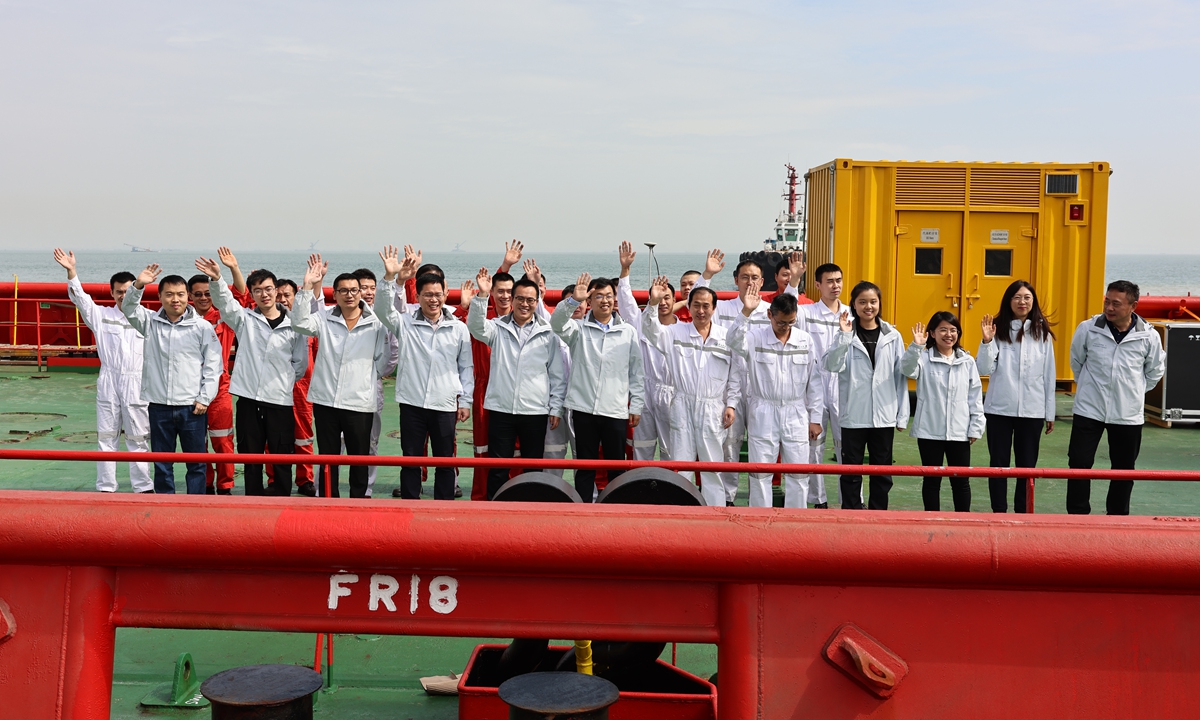
Crew members of Zhong Shan Da Xue Ji Di, China's third icebreaker, wave to the public after they return to a port in Guangzhou, South China's Guangdong on February 3, 2023. Photo:Deng Xiaoci/GT
Joining forces
Different from the members of national team of Xuelong and Xuelong-2, Zhao, who participated in the 36th Antarctic expedition, noted that the university's ownership of the new icebreaker could facilitate scientific exchange and cooperation with global researchers, despite the ever-changing international situation.
Sun Yat-sen University is the leading force in the Chinese university alliance for polar region research. The Zhong Shan Da Xue Ji Di is projected to be a common science and research platform for universities.
So far, more than a dozen of the most prestigious Chinese universities including Tsinghua University, Tongji University, Wuhan University, and Dalian Ocean University have participated in the program. And in the future, more journeys aboard the Zhong Shan Da Xue Ji Di will be scheduled according to the universities' specific research goals, Cheng revealed.
Zhong Shan Da Xue Ji Di is also expected to join forces with China's Xuelong and Xuelong-2 icebreakers in the future.
As China's independently developed polar icebreaker and scientific research vessel, Xuelong-2 is 122.5 meters long and 22.32 meters wide, with a designed displacement of 13,996 tons. It can continuously break ice as thick as 1.5 meters at a speed of 2 knots (3.70 kilometers per hour) to 3 knots.
According to Cheng, Xuelong, which was procured from Ukraine in 1993, is more suited for a cargo vessel role in polar exploration. Although Xuelong and Xuelong-2 have already formed a dream team for the country's polar quest, generally speaking, China's polar region entry capability is relatively weak.
The chances of expeditions to the polar region provided by the two "snow dragons" are still very scarce, which to a great extent limits their research capabilities and depth of research, Cheng said.
China has so far conducted 39 Antarctic scientific explorations since the first in 1984 and 12 Arctic quests since the first in 1999, accumulating rich scientific experience through survey findings, and has formed a research matrix of "two vessels, seven research stations, and one polar fixed-wing aircraft."
Insiders have told the Global Times that China is still in the second tier when it comes to polar science and research capability, and that there is a gap between China and advanced countries such as the US and certain European countries.
There could be more than 4,000 personnel stationed at one US Antarctic station every year, but our research vessels can only bring slightly over 200 to the region each year. The difference in sheer manpower is huge, one of the insiders told the Global Times.
Although China has issued national reports on the polar situation in the Antarctic and Arctic, data used by Chinese scientists is primarily sourced from foreign peers, and the amount of original data is too scarce to match China's status as an international science and research power, Cheng admitted.
It would be an urgent task for the country to innovate and improve its polar entry capabilities. Only when we can attain more first-hand observation, can we better participate in polar governance, build a community with a shared future, and have a better say in international affairs related to polar affairs, Cheng said.
The emergence of the Zhong Shan Da Xue Ji Di will hopefully improve the situation. "It has a smaller tonnage at half that of the Xuelong-2 and only a quarter of the Xuelong, which gives it better agility. It also possesses better self-sustainability than Xuelong and Xuelong-2," Cheng explained.
If we can fully harness its advantages and form a strong fleet with Xuelong, Xuelong-2, as well as the Zhong Shan Da Xue large research vessel [which is capable of cruising in the low ice concentration sea areas], we can greatly boost our research capability in the polar and near-polar regions, Cheng said.
Xie Peng, the vice director of the Sun Yat-sen University's polar research center, told the Global Times that we can learn about climate change and glacier melting among other issues through polar research, which are also crucial fields for international cooperation and will benefit mankind as a whole.
"Polar capability is also listed as one of the main fields in national security together with homeland security, deep sea security, and outer space security." Xie said.

